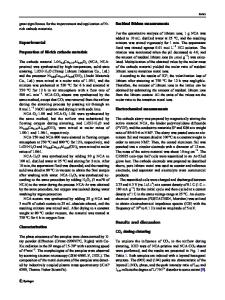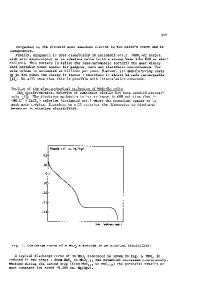In situ XAFS study on cathode materials for lithium-ion batteries
- PDF / 162,939 Bytes
- 5 Pages / 595 x 842 pts (A4) Page_size
- 13 Downloads / 398 Views
In situ XAFS study on cathode materials for lithium-ion batteries Takamasa Nonaka, Chikaaki Okuda, Yoshio Ukyo and Tokuhiko Okamoto TOYOTA Central Research & Development Laboratories., Inc., Nagakute, Aichi, 480-1192, Japan ABSTRACT Ni and Co K-edge X-ray absorption spectra of LiNi0.8Co0.2O2 have been collected using in situ coin cells. To investigate the electronic and structural changes accompanied by the capacity fading during electrochemical cycling and keeping batteries at high temperatures, the cells with different cycling states and keeping conditions (temperature, time) were prepared. Upon charging the cell, the Ni and Co K absorption edge shifted towards higher energy, and the good correlation between the range of chemical shifts upon charging and the capacity of the cell was observed. From quantitative analysis of EXAFS data, it was revealed that the capacity fading is closely related to the Jahn-Teller distortion of the NiO6 octahedron. INTRODUCTION LiNi0.8Co0.2O2 is one of the current candidates for a cathode material of advanced rechargeable batteries with high capacity. It is known that the stability of LiNi0.8Co0.2O2 is superior to that of LiNiO2 because of exhibiting a single-phase region upon oxidation from 3.0V to 4.1V [1]. However, the capacity fading occurs not only during charge/discharge cycling but also when batteries are kept at high temperatures. And this capacity fading is most important problem for practical use. From the standpoint of overcoming the capacity fading, it is essential to understand the electronic and structural changes accompanied by the capacity fading. For this purpose, in situ XAFS analysis is very useful, because it will give the information on the local structure around an absorber atom and its electronic structure without destructing the battery for a measurement. Some studies applying in situ XAFS analysis for LiNiO2 or LiCoO2 have been already reported [2-3]. But an in situ XAFS study on the capacity faded battery has not been reported yet. So we prepared the batteries with various capacities and have measured in situ Ni and Co K-edge absorption spectra of LiNi0.8Co0.2O2. EXPERIMENTAL DETAILS Figure 1 shows a drawing of the coin cell newly developed for in situ XAFS measurements in a transmission mode. By using 0.4 mm Beryllium windows, the X-rays can penetrate throw the cell. XAFS data can be obtained at various voltages without taking out the cathode material from the cell. To investigate the changes resulting from cycling and keeping at high temperatures, the cells with different cycling states and keeping conditions (temperature, time) were prepared. The cells used in this study are listed in Table I. Ni and Co K-edge XAFS data were collected using beamline BL16B2 in SPring-8 (Hyogo, Japan). The incident X-rays were monochromatized using Si (111) double-crystal monochromator, and the harmonic content of the beam was minimized by Rh-coated Si mirror inclined to 5 mrad. The X-ray intensities were monitored using ionization chambers filled with
GG9.6.1
nitrogen g
Data Loading...











